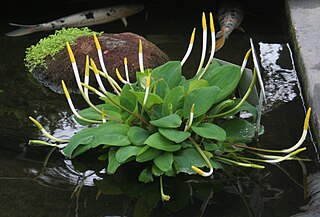
The Burkholderiales are an order of Pseudomonadota. Like all Pseudomonadota, they are Gram-negative. They include several pathogenic bacteria, including species of Burkholderia, Bordetella, and Ralstonia. They also include Oxalobacter and related genera, which are unusual in using oxalic acid as their source of carbon. Other well-studied genera include Alcaligenes, Cupriavidus, Achromobacter, Comamonas, Delftia, Massilia, Duganella, Janthinobacterium, Polynucleobacter, non-pathogenic Paraburkholderia, Caballeronia, Polaromonas, Thiomonas, Collimonas, Hydrogenophaga, Sphaerotilus, Variovorax, Acidovorax, Rubrivivax and Rhodoferax, and Herbaspirillum.
Stylidium aquaticum is a dicotyledonous plant that belongs to the genus Stylidium. The specific epithet aquaticum refers to this species' typical habitat. It is an annual plant that grows from 18 to 30 cm tall. Linear leaves, about 20-100 per plant, are scattered along the elongate, glabrous stem. The leaves are generally 1.7–11 mm long and 0.1-0.3 mm wide. Petioles and scapes are absent. Inflorescences are 3–8 cm long. Flowers are pink or white. S. aquaticum is only known from its type location in northwestern Northern Territory of Australia. Its habitat is recorded as being a Melaleuca viridiflora swamp, growing in shallow water at a depth of around 7 cm. It flowers in the southern hemisphere in May. S. aquaticum is most closely related to S. fissilobum but differs mostly in the leaf shape. Its conservation status has been assessed as data deficient.

Orontium aquaticum, sometimes called golden-club, floating arum, never-wets or tawkin, is a species of flowering plants in the family Araceae. It is the single living species in the genus Orontium, which also contains several extinct species described from fossils. O. aquaticum is endemic to the eastern United States and is found growing in ponds, streams, and shallow lakes. It prefers an acidic environment. The leaves are pointed and oval with a water repellent surface. The inflorescence is most notable for having an extremely small almost indistinguishable sheath surrounding the spadix. Very early in the flowering this green sheath withers away leaving only the spadix.

Orontium, sometimes called golden-club, is a genus of flowering plants in the family Araceae. The single living species in the genus is Orontium aquaticum, while the two other described species, Orontium mackii and Orontium wolfei, are known from fossils.
Herbaspirillum aquaticum is a bacterium of the genus Herbaspirillum.
Exiguobacterium is a genus of bacilli and a member of the low GC phyla of Bacillota. Collins et al. first described the genus Exiguobacterium with the characterization of E. aurantiacum strain DSM6208T from an alkaline potato processing plant. It has been found in areas covering a wide range of temperatures (-12 °C—55 °C) including glaciers in Greenland and hot springs in Yellowstone, and has been isolated from ancient permafrost in Siberia. This ability to survive in varying temperature extremes makes them an important area of study. Some strains in addition to dynamic thermal adaption are also halotolerant, can grow within a wide range of pH values (5-11), tolerate high levels of UV radiation, and heavy metal stress.
Chryseobacterium aquaticum is a Gram-negative, non-spore-forming and non-motile bacteria from the genus of Chryseobacterium.
Flavobacterium aquaticum is a Gram-negative bacterium from the genus of Flavobacterium which has been isolated from water from a rice field from Jamdih in India.
Pontimicrobium is a Gram-negative, strictly aerobic, non-spore-forming, rod-shaped and non-motile genus of bacteria from the family of Flavobacteriaceae with one known species. Pontimicrobium aquaticum has been isolated from seawater.
Exiguobacterium acetylicum is a bacterium from the genus of Exiguobacterium.
Exiguobacterium aestuarii is a Gram-variable and rod-shaped bacterium from the genus of Exiguobacterium which has been isolated from tidal flat from the beach of Daepo in Korea.
Exiguobacterium alkaliphilum is a Gram-positive, rod-shaped, facultatively anaerobic and alkaliphilic bacterium from the genus of Exiguobacterium which has been isolated from alkaline wastewater drained sludge from New Delhi.
Exiguobacterium aurantiacum is a Gram-positive, alkaliphilic, halotolerant and non-spore-forming bacterium from the genus of Exiguobacterium which has been isolated from human blood.
Exiguobacterium enclense is a Gram-positive bacterium from the genus of Exiguobacterium which has been isolated from marine sediments from the Chorão island.
Exiguobacterium indicum is a Gram-positive, psychrophilic, non-spore-forming, alkaliphilic, rod-shaped and motile bacterium from the genus of Exiguobacterium which has been isolade from the Hamta glacier.
Exiguobacterium marinum is a bacterium from the genus of Exiguobacterium.
Exiguobacterium oxidotolerans is a Gram-positive, alkaliphilic, facultative anaerobic and motile bacterium from the genus of Exiguobacterium which has been isolated from a fish processing plant.
Exiguobacterium profundum is a Gram-positive, halotolerant, facultative anaerobic, moderately thermophilic and non-spore-forming bacterium from the genus of Exiguobacterium which has been isolade from a hydrothermal vent from the East Pacific Rise.
Exiguobacterium soli is a psychrophilic bacterium from the genus of Exiguobacterium which has been isolated from the McMurdo Dry Valleys.
Exiguobacterium undae is a species of Bacilli. Its discovery was published in the International Journal of Systematic and Evolutionary Microbiology. This species has the ability to metabolize arabinose, cellulose, fructose, and glucose. It may undergo fermentation by utilizing D-glucose, D-mannitol, D-ribose, and glycogen. E. undae is motile and it contains peritrichous flagella.

